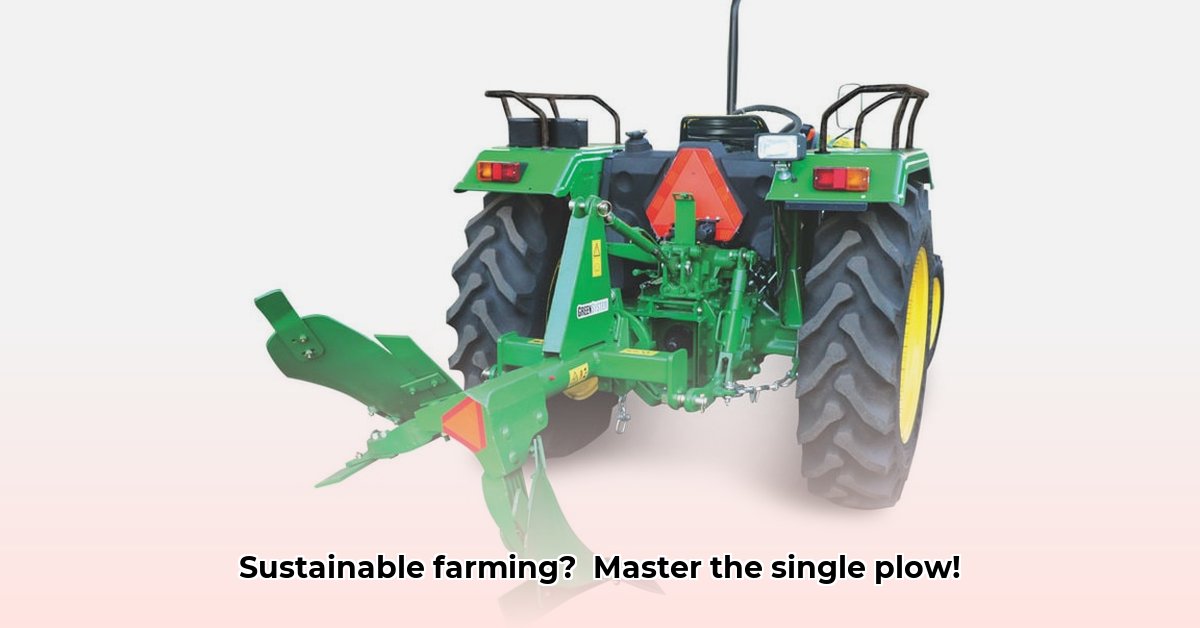
Choosing the Right Single Plow
Selecting the right single plow for your tractor is crucial for efficient and sustainable tillage. The wrong choice can lead to damaged equipment, wasted time, and reduced yields. This guide helps you navigate the selection process, ensuring you get the best tool for your needs. For information on land preparation before plowing, check out this guide on tractor driveway grading.
Matching Plow Size to Tractor Horsepower
The most critical factor is matching the plow's size to your tractor's horsepower (HP). Underpowering the plow leads to inefficient operation and potential damage. Overpowering is less of a concern, but it also leads to wasted resources. This chart provides approximate guidelines; always consult your tractor's manual for precise recommendations. Soil type significantly impacts the required power for effective plowing.
| Tractor Horsepower (HP) | Recommended Plow Width (inches) | Soil Type Notes |
|---|---|---|
| 15-20 | 10-12 | Best for lighter soils, small gardens, or minimal tilling. |
| 20-25 | 12-14 | Works well for a variety of soils, a good choice for most small-scale farmers. |
| 25-35 | 14-16 | Ideal for heavier soils and larger fields. |
| 35+ | 16+ | You might want a larger plow or consider making multiple passes for best results. |
Note: This table offers general guidelines. Actual needs vary due to soil conditions, plow design, and the specific tractor model.
Isn't it frustrating to struggle with a plow that's too big or too small for your tractor? Choosing the right size ensures efficient operation and protects your equipment.
Key Plow Components and Specifications
Beyond size, the plow's construction determines its durability and performance. Three key areas are crucial:
- Plowshare: This is the cutting edge that initially breaks the soil. Hardened steel is ideal for longevity and efficient cutting.
- Moldboard: This curved surface inverts and turns the soil. The moldboard's design influences soil turnover and the final tilth (the condition of the soil after plowing).
- Frame: This provides structural support for the entire plow. A robust frame is essential to withstand stress during operation.
Durable materials, such as high-carbon steel, ensure a longer lifespan and superior performance. Consider plows with easily adjustable depth and angle settings for enhanced control and versatility.
Hitch Types and Compatibility
The hitch system connects the plow to your tractor. Quick-hitch systems significantly reduce setup time, while standard 3-point hitches are reliable but require more time for attaching and detaching. Ensure compatibility before purchase.
- Quick-Hitch: Offers fast attachment and detachment, ideal for efficiency.
- Standard 3-Point Hitch: Provides a reliable connection, but attachment and detachment require more time and effort.
Choosing the correct hitch type depends on your needs and tractor capabilities.
Shear Bolt Protection: A Critical Safety Feature
Shear bolts are designed to break under excessive stress, protecting your tractor and plow from damage. Choose a plow with readily available replacement shear bolts to minimize downtime. This safety feature is essential for preventing costly repairs. Did you know that a proactive approach to shear bolt maintenance can reduce downtime by up to 90%?
Operating and Maintaining Your Single Plow
Operating Procedures: A Step-by-Step Guide
- Pre-Operation Check: Inspect the plow for damage or loose parts. Ensure the hitch is securely attached to your tractor.
- Depth Adjustment: Set the plow's depth appropriately for your soil conditions. Start shallow and gradually increase the depth as needed.
- Consistent Speed and Overlap: Maintain a steady speed suitable for your soil and plow size. Slightly overlap each pass for complete tillage.
- Ongoing Monitoring: Continuously monitor the plow's performance and adjust speed and depth accordingly for optimal results.
- Safety Precautions: Always wear protective gear and be aware of surrounding hazards.
Troubleshooting Common Problems
- Clogging: This usually is due to wet or sticky soil. Address it by adjusting the depth or speed.
- Uneven Plowing: Check the depth settings and ensure the plow is properly adjusted.
- Shear Bolt Failure: Replace the broken shear bolt with a new one of the same specification.
Maintenance Schedule
Regular maintenance is vital for prolonging the plow's lifespan and ensuring optimal performance. This includes periodic lubrication of moving parts, inspection for wear and tear, and proper storage when not in use.
Selecting Your Plow: A Practical Guide
Your final choice depends on your budget, soil type, tractor compatibility, and personal preferences. Compare specifications and read online reviews before purchasing. Consulting with experienced farmers offers invaluable insights.
Appendix: Model Comparison (Example)
(Note: This section would be populated with data from manufacturer websites and user reviews, comparing specific models. The table would include weight, materials, ease of adjustment, reported repair rates, and other relevant data.)
This comprehensive guide helps you select, operate, and maintain your single-bottom moldboard plow for sustainable and efficient tillage. Remember, selecting the right equipment is a foundation for successful farming.